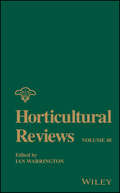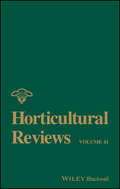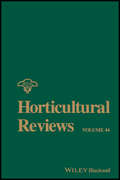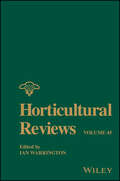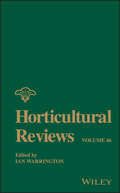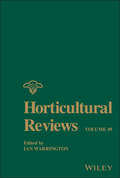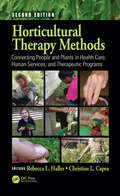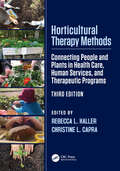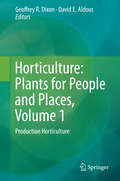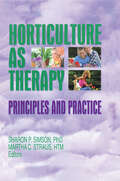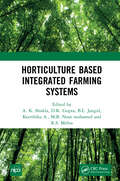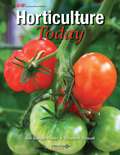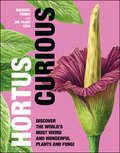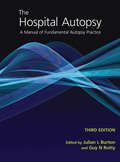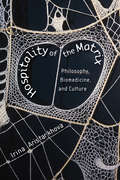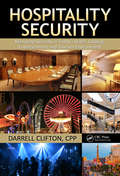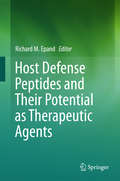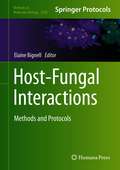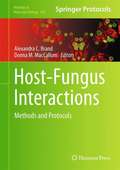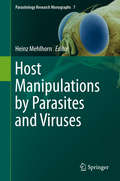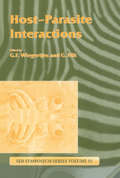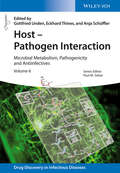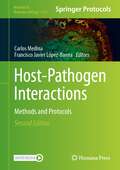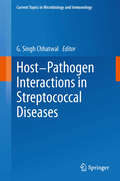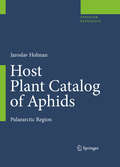- Table View
- List View
Horticultural Reviews (Horticultural Reviews)
by Ian WarringtonHorticultural Reviews presents state-of-the-art reviews on topics in horticultural science and technology covering both basic and applied research. Topics covered include the horticulture of fruits, vegetables, nut crops, and ornamentals. These review articles, written by world authorities, bridge the gap between the specialized researcher and the broader community of horticultural scientists and teachers.
Horticultural Reviews, Horticultural Reviews
by Jules JanickHorticultural Reviews presents state-of-the-art reviews on topics in horticultural science and technology covering both basic and applied research. Topics covered include the horticulture of fruits, vegetables, nut crops, and ornamentals. These review articles, written by world authorities, bridge the gap between the specialized researcher and the broader community of horticultural scientists and teachers.
Horticultural Reviews Volume 43
by Jules JanickDedication: Chad E. FinnJohn R. Clark Light-Emitting Diodes in HorticultureC.A. Mitchell, J.F. Burr, M.J. Dzakovich, C. Gómez, R. Lopez, R. Hernández, C. Kutoba, C.J. Currey, Q. Meng, E.S. Runkle, C.M. Bourguet, R.C. Murrow, and A.J. Both Chayote: Pre-Columbian Origins and DispersaFernando A. Moreira Ragwort: Invasive Weed and Potential PharmaceuticalCatherina M. O'Keeffe, Gary W. Stutte, and Michelle McKeon-Bennett Advances and Trends in Organic Fruit and Vegetable Farming ResearchMartine Dorais and Beatrix Alsanius Western Botanical Gardens: History and EvolutionDonald A. Rakow and Sharon A. Lee The Future of Global Banana ProductionRandy C. Ploetz and Edward A. Evans
Horticultural Reviews, Volume 45
by Ian WarringtonHorticultural Reviews presents state-of-the-art reviews on topics in horticultural science and technology covering both basic and applied research. Topics covered include the horticulture of fruits, vegetables, nut crops, and ornamentals. These review articles, written by world authorities, bridge the gap between the specialized researcher and the broader community of horticultural scientists and teachers.
Horticultural Reviews, Volume 46 (Horticultural Reviews)
by Ian WarringtonHorticultural Reviews presents state-of-the-art reviews on topics in horticultural science and technology covering both basic and applied research. Topics covered include the horticulture of fruits, vegetables, nut crops, and ornamentals. These review articles, written by world authorities, bridge the gap between the specialized researcher and the broader community of horticultural scientists and teachers.
Horticultural Reviews, Volume 49 (Horticultural Reviews)
by Ian WarringtonHorticultural Reviews Contents Contributors vii Dedication: Dr. Christopher B. Watkins xi Oakleaf Hydrangea (Hydrangea quercifolia Bartr.): Horticulture, Genetics, Breeding, and Conservation 1 Biostimulants in Agricultural and Horticultural Production 35 Postharvest Physiological Disorders of Banana Fruit: Finger Drop, Senescent Spotting, and Chilling Injury 97 Mechanical Harvesting of Selected Temperate and Tropical Fruit and Nut Trees 171 Apple Fruitlet Abscission Mechanisms 243
Horticultural Therapy Methods: Connecting People and Plants in Health Care, Human Services, and Therapeutic Programs, Second Edition
by Rebecca L. Haller Christine L. CapraHorticultural therapy has evolved from its use only by volunteer gardeners to become a recognized and respected therapeutic modality conducted by trained, registered professionals. Horticultural Therapy Methods is the first textbook to describe the processes and techniques used to provide horticultural therapy interventions and the rationale for their use. This book presents types of programs, settings, and goals in horticultural therapy. It outlines treatment planning; development of sessions to meet treatment objectives; motivation and behavior management techniques; documentation guidelines; practical approaches for wellness; and resources for activity ideas. New to this Edition: Various useful examples of horticultural therapy in practice and strategically placed tips and resources. Additions to appendix on horticultural therapy treatment strategies. New chapter on session planning. Thirty-seven photographs demonstrating horticultural therapy in practice. Additional "HT Practice" examples and tips. The book is used as a reference and a guide for students, educators, and those conducting horticultural therapy or therapeutic horticulture to guide them in constructing effective treatment programs. Health care and human service professionals use the reference in the therapy, treatment, and education of inmates, residents, patients, trainees, students, and other participants.
Horticultural Therapy Methods: Connecting People and Plants in Health Care, Human Services, and Therapeutic Programs
by Rebecca L. Haller and Christine L. CapraHorticultural Therapy Methods: Connecting People and Plants in Health Care, Human Services, and Therapeutic Programs was the first text to describe the processes and techniques used to provide horticultural therapy interventions, and the rationale for their use. The first edition was written to positively impact the professional practice of horticultural therapy and provide an array of strategies for horticultural therapy treatment. Prior to its publication, the topics had only been addressed by other allied professions but had not been specifically tailored for horticultural therapy. The second edition updated the material, added essential information on planning treatment sessions, and provided techniques to address treatment issues for mental health, physical health, vocational skills, and wellness. This third edition revises all chapter content, improves and expands appendices, adds a chapter on building relationships, provides new photos, and includes additional case examples, in addition to providing discussion questions, references, further reading, and key concepts.Horticultural Therapy Methods is a clear instructive manual that explains: The process of treatment planning in horticultural therapy Session development, including activity or task selections to meet treatment objectives Therapeutic use of self and relationship building Motivation and behavior management techniques Adaptations and modifications to enable and challenge program participants How to maximize active engagement in horticulture and cultivation of plants Treatment documentation guidelines Practical approaches for mental health and other areas of practice Horticultural Therapy Methods: Connecting People and Plants in Health Care, Human Services, and Therapeutic Programs, Third Edition, is a reference and guide for students, educators, and those using horticulture for therapeutic purposes to help construct effective treatment programs. Health care and human service professionals can use this reference in the therapy, treatment, and education of inmates, residents, patients, trainees, students and others. The aim of this book is to guide novice and experienced horticultural therapists to use accepted human service practices that are aligned with allied professions.
Horticulture: Plants for People and Places, Volume 2
by Geoffrey R. Dixon David E. AldousThis Trilogy explains "What is Horticulture?". Volume two of Horticulture: Plants for People and Places analyses in depth the scientific, managerial and ecological concepts which underpin Environmental Horticulture. Chapters describe: Horticulture and the Environment, Woody Ornamentals, Herbs and Pharmaceuticals, Urban Greening, Rural Trees, Urban Trees, Turfgrass Science, Interior and External Landscaping, Biodiversity, Climate Change and Organic Production. Each is written by leading international experts. Sustainable use of resources and careful conservation are critically essential for the continuation of life on this Planet. Achieving this is where horticulture, natural flora and fauna and the environment interact in achieving sustainable development. Horticulture is the fundamental partner of ecological and environmental science and provides an understanding of eco-system services. Live plant networks are essential for rural and urban life. They are integral parts of natural communities, the context of historic and modern architecture and a means for rejuvenating cities and uniting communities. Plants provide urban, peri-urban and rural employment, business and tourism opportunities, leisure, rest and relaxation. These facets of Environmental Horticulture are clearly described in this book.
Horticulture as Therapy: Principles and Practice
by Sharon Simson Martha StrausDid you know that plants and plant products can be used to improve people’s cognitive, physical, psychological, and social functioning? Well, they can, and Horticulture as Therapy is the book to show you how! If you are already familiar with the healing potential of horticultural therapy, or even practice horticultural therapy, this book will help you enrich your knowledge and skills and revitalize your practice. You will learn how horticultural therapy can be used with different populations in a variety of settings, what resources are available, effective treatment strategies, and the concepts behind horticultural treatment.The first comprehensive text on the practice of horticulture as therapy, this one-of-a-kind book will enable the profession to educate future horticultural therapists with fundamental knowledge and skills as they embark on careers as practitioners, researchers, and educators. You come to understand the relationship between people and plants more deeply as you learn about: vocational, social, and therapeutic programs in horticulture special populations including children, older adults, those who exhibit criminal behavior, and those with developmental disabilities, physical disabilities, mental health disorders, or traumatic brain injury use of horticultural therapy in botanical gardening and community settings adaptive gardening techniques applied research documentation and assessment in horticultural practice Horticulture as Therapy establishes, integrates, and communicates a foundation of knowledge for horticultural therapists, other therapists, horticulturists, students, research scientists, gardeners, and others interested in this special and unique kind of therapy. By reading Horticulture as Therapy, you will see how you can make a difference in the health and well-being of so many people, today and tomorrow.
Horticulture Based Integrated Farming Systems
by A. K. Shukla D. K. Gupta B. L. Jangid Keerthika A. M.B. Noor mohamed R. S. MehtaThe content of this book provides information on advanced knowledge in the sphere of importance and scope of horticulture in India, horticulture based integrated farming systems, integration of livestock in horticulture based farming systems, emerging issues, natural resource management, disease and pest management, organic farming and certification, post-harvest measures and value addition in arid fruits and vegetables, marketing aspects, status and export promotion measures and procedures. Note: T&F does not sell or distribute the hardback in India, Pakistan, Nepal, Bhutan, Bangladesh and Sri Lanka. This title is co-published with NIPA.
Horticulture Today
by Jodi Songer Riedel Elizabeth DriscollAn all-new option for introductory horticulture or plant science courses, Horticulture Today engages students with practical information they can use and hands-on activities they perform. Written by two dynamic agriculture educators, the text presents a contemporary overview of the horticulture industry, then provides thorough coverage of plant science, horticultural practices, landscape design and maintenance, and integrated pest management. In developing an appreciation for the diversity and global context of horticulture, Horticulture Today helps students to develop literacy in Green Industry careers as well as the skills they will need to succeed.
Hortus Curious: Discover the World's Most Weird and Wonderful Plants and Fungi
by Michael PerryCelebrate the weird, wacky, and wonderful world of plants with a book that revels in the diversity of the botanical world.Plants are truly awe-inspiring. They can be vast, minute, smelly, or spectacularly ugly. Some plants live on their own, or by growing off others; some live by air and water; others are carnivorous, eating the creatures around them; some plants look remarkably like animals; while others have unusual symbolism; and some have special cultural significance. This book explores them all, bringing together the most peculiar and most fascinating plants on the planet – celebrating them in all their diverse splendor.Split into five chapters, covering everything from poisonous plants to painkilling ones, Michael Perry explains exactly what makes each plant special. With exquisitely detailed illustrations of all the different species, this is an informative, humorous, and beautiful gift for all those who love plants – whether they want to grow them or not. Hortus Curious delivers a different way to view the plant world and enjoy it for its bonkers and bizarre.The book is split into five chapters, covering:- Plants Behaving Badly – the criminal world of plants such as poisonous plants, insect catching plants, and plants that do risky thing- Mistaken Identity – plants that look like other things, e.g. flowers that look like monkeys, bees, or even dead man&’s fingers- Greater Good – did you know that aspirin comes from a plant? This chapter explores the plants that make up our everyday products- Superheroes – find out about the plants that can disguise themselves, changing color, shape or even moving themselves- X-rated Plants – a selection of the rudest plants out there!A humorous and quirky gift book for people interested in plants and gardening, Hortus Curious is sure to delight.
The Hospital Autopsy: A Manual of Fundamental Autopsy Practice, Third Edition
by Guy Rutty Julian BurtonNow in full colour, this new and revised edition of The Hospital Autopsy presents a clear and systematic approach to safe and effective modern autopsy practice for pathologists. It begins by discussing issues such as legislation governing autopsies, religious attitudes and ensuring safety, before covering the procedures of external examination, evi
Hospitality of the Matrix: Philosophy, Biomedicine, and Culture
by Irina AristarkhovaThe question "Where do we come from?" has fascinated philosophers, scientists, and artists for generations. This book reorients the question of the matrix as a place where everything comes from (chora, womb, incubator) by recasting it in terms of acts of "matrixial/maternal hospitality" producing space and matter of and for the other. Irina Aristarkhova theorizes such hospitality with the potential to go beyond tolerance in understanding self/other relations. Building on and critically evaluating a wide range of historical and contemporary scholarship, she applies this theoretical framework to the science, technology, and art of ectogenesis (artificial womb, neonatal incubators, and other types of generation outside of the maternal body) and proves the question "Can the machine nurse?" is critical when approaching and understanding the functional capacities and failures of incubating technologies, such as artificial placenta. Aristarkhova concludes with the science and art of male pregnancy, positioning the condition as a question of the hospitable man and newly defined fatherhood and its challenge to the conception of masculinity as unable to welcome the other.
Hospitality Security: Managing Security in Today's Hotel, Lodging, Entertainment, and Tourism Environment
by Darrell CliftonA security director must have knowledge of criminal and civil law, risk and personnel management, budgeting and finance, and a host of other areas in order to be effective. Hospitality Security: Managing Security in Today's Hotel, Lodging, Entertainment, and Tourism Environment provides experience-based, proven methods for preventing and resolving the challenges faced by today's hospitality practitioner. Designed for both novice security professionals and industry veterans in need of a reference, the book covers: Risk assessment, where threats and vulnerabilities are calculated with probabilities to determine risk The security plan, where you decide how to apply various layers of control to mitigate the risks Budgeting: the amount of money available to implement the plan determines the next step Policies: how to document policies into a security manual, training manual, emergency procedures manual, and incident action plan Staffing: scheduling, wages, deployment, and contract security Training, including specialized topics such as use of force and bike patrol Physical security and patrol procedures Alarm and camera systems and various software programs Emergency procedures and response Investigations, interviews, and crime analysis Executive skills: learning from proven leadership styles Ideal for novices and veterans alike, this accessible, reader-friendly primer enables security directors to evaluate what risks are inherent to hospitality environments, analyze those risks through threat and vulnerability assessments, and develop methods to mitigate or eliminate them-all the while keeping customers and personnel safe and improving the bottom line.
Host Defense Peptides and Their Potential as Therapeutic Agents
by Richard M. EpandThis book offers an overview of our current understanding of host defense peptides and their potential for clinical applications as well as some of the obstacles to this. The chapters, written by leading experts in the field, detail the number and diversity of host defense peptides, and discuss the therapeutic potential not only of antibacterial, but also of antifungal, antiviral, plant antimicrobial and anticancer host defense peptides. The authors provide new insights into their mechanisms of action and their immunomodulatory properties, and review recent advances in the design of novel therapeutic molecules. Lastly, their potential to prevent preterm births and Staphylococcus aureus infections is highlighted. The book is of interest to researchers, industry and clinicians alike.
Host-Fungal Interactions: Methods and Protocols (Methods in Molecular Biology #2260)
by Elaine BignellThis volume provides readers with essential protocols for dissecting the host-fungus interaction, and engages researchers in study of mammalian disease. Written in the highly successful Methods in Molecular Biology series format, chapters include introductions to their respective topics, lists of the necessary materials and reagents, step-by-step, readily reproducible laboratory protocols, and tips on troubleshooting and avoiding known pitfalls. Authoritative and cutting-edge, Host-Fungal Interactions: Methods and Protocols aims to ensure successful results in the further study of this vital field.
Host-Fungus Interactions: Methods and Protocols (Methods in Molecular Biology #845)
by Donna M. Maccallum Alexandra C. BrandMicrobiologists, medical mycologists, immunologists, and biochemists are increasingly working together to focus on the processes involved in the progression and treatment of fungal disease. Host-Fungus Interactions: Methods and Protocols is designed for research scientists who are involved in this work and interested in undertaking new or comparative studies of interactions between the mammalian host and clinically important fungal pathogens. Aiming to combine approaches for reverse genetics in pathogenic fungi with methods for their application in in vitro and in vivo models of disease, the book includes methods for the culture and genetic manipulation of the primary fungal pathogens and the opportunistic pathogens, as well as methods for investigating host-fungus interactions in model systems. Written in the highly successful Methods in Molecular BiologyTM series format, chapters include introductions to their respective topics, lists of the necessary materials and reagents, step-by-step, readily reproducible laboratory protocols, and tips on troubleshooting and avoiding known pitfalls. Comprehensive and practical, Host-Fungus Interactions: Methods and Protocols describes available molecular methods and fungal infection models in great detail in order to encourage researchers to try new approaches to investigating host-fungus interactions with added levels of confidence.
Host Manipulations by Parasites and Viruses
by Heinz MehlhornThis edited volume focuses on parasite-host relationships and the behavioral changes parasites may trigger in their hosts. Parasites have developed strategies which enhance their chances to find a host to survive inside its body and to become most easily transmitted to one another. Many of these parasites influence the host's behavior by various mechanisms, so that the rate of their transmissions to further hosts becomes considerably enhanced in comparison to that of non-influenced specimens of the same host species. A broad number of recent studies elucidate more and more examples in an extreme spectrum of host-parasite relationships, where successful transmission and /or survival of a parasite inside a host is based on parasite-derived behavioral manipulations of the hosts. In the literature, an increasing numbers of papers appear which prove that these behavioral alterations are based on complicated psychoimmunologic, neuropharmacologic and genomically steered mechanisms. Researchers working in parasitology or behavioral sciences will find this work thought-provoking, instructive and informative.
Host-Parasite Interactions (Society for Experimental Biology)
by G. F. WIEGERTJES AND G. FLIKThis volume summarizes current research into the physiology and molecular biology of host-parasite interactions. Brought together by leading international experts in the field, the first section outlines fundamental processes, followed by specific examples in the concluding section. Covering a wide range of organisms, Host-Parasite Interactions is essential reading for researchers in the field.
Host - Pathogen Interaction: Microbial Metabolism, Pathogenicity and Antiinfectives
by Gottfried Unden Anja Schuffler Eckhard ThinesIn light of the rapidity increasing incidence rate of bacterial and fungal infections with multi-resistant pathogens, the metabolic changes associated with host-pathogen interactions offer one of the most promising starting points for developing novel antibiotics. . Part one of this comprehensive guide describes the metabolic adaptation of pathogenic microbes in humans, while part two points to routes for the development of novel antibiotics. This is volume six of the book series on drug discovery in infectious diseases by Paul Selzer.
Host-Pathogen Interactions: Methods and Protocols (Methods in Molecular Biology #2751)
by Carlos Medina Francisco Javier López-BaenaThis fully updated volume serves as multidisciplinary compendium of approaches and techniques employed to analyze the role of different molecules, processes, or strategies used by different guests to survive and proliferate in their associations with eukaryotic hosts. Beginning with animal-pathogen interactions, the book then continues with chapters exploring virus-host interactions, plant-microbe interactions, as well as different molecular techniques that were initially applied to non-pathogenic interactions but can be adapted to study other host-pathogen associations. Written for the highly successful Methods in Molecular Biology series, chapters include introductions to their respective topics, lists of the necessary materials and reagents, step-by-step and readily reproducible laboratory protocols, as well as tips for troubleshooting and avoiding known pitfalls.Authoritative and up-to-date, Host-Pathogen Interactions: Methods and Protocols, Second Edition contributes to the study of host-pathogen interactions with numerous techniques that can be used in a variety of bacteria.
Host-Pathogen Interactions in Streptococcal Diseases
by G Singh ChhatwalStreptococci are Gram-positive bacteria that cause a wide spectrum of diseases, such as pharyngitis, necrotizing fasciitis and streptococcal toxic shock syndrome, as well as rheumatic fever and rheumatic heart disease as sequelae. Antibiotics alone have not been able to control the disease and in spite of many efforts an effective vaccine is not yet available. A prerequisite for novel and successful strategies for combating these bacteria is a complete understanding of the highly complex pathogenic mechanisms involved, which are analyzed in this volume. In ten chapters, prominent authors cover various aspects including streptococcal diseases and global burden, epidemiology, adaptation and transmission, and molecular mechanisms of different diseases, as well as sequelae, vaccine development and clinical management. This book will serve as a valuable reference work for scientists, students, clinicians and public health workers and provide new approaches to meeting the challenge of streptococcal diseases.
Host Plant Catalog of Aphids
by Jaroslav HolmanThis catalog presents host lists of particular aphid species in the Palaearctic Region based on published data and more than 2,400 of the author's unpublished host records, with respective references arranged by geographical provenance. The book includes separate lists of aphids living on particular plants, arranged in alphabetical order of plant families and genera, separately for mosses, ferns, gymnosperms, dicotyledons and monocotyledons.
